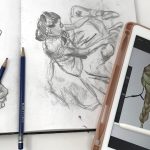
Rapid Prototyping with AR: Pushing the Frontiers of Virtual Product Design
- Post
- August 7, 2023
- Prototyping, UI/UX Design, Web Design
- 0 Comments
In the ever-evolving landscape of product design, the integration of Augmented Reality (AR) has emerged as a revolutionary force, reshaping the traditional paradigms of rapid prototyping. This transformative technology has opened new avenues for designers and developers to harness its power for crafting, testing, and refining virtual products. In this comprehensive exploration, we delve deep into the synergy between rapid prototyping and AR, unlocking the potential that lies within the convergence of these two dynamic fields.
Understanding Rapid Prototyping and Its Evolution
Rapid prototyping, at its core, is a methodology that accelerates the design process by quickly creating tangible models of a product. Historically, it has relied on 3D printing and other advanced manufacturing techniques. However, the infusion of AR has ushered in a new era, where digital and physical realms coalesce seamlessly. By merging these realms, designers can fabricate interactive virtual prototypes, expediting the development cycle and fostering innovation.
The AR Advantage in Virtual Product Design
Intuitive Visualization and Iteration
AR empowers designers to visualize virtual prototypes within real-world environments. This dynamic visualization not only enhances the depth of understanding but also provides a platform for iterative improvements. Designers can scrutinize how virtual products behave in different scenarios, enabling them to fine-tune elements for optimal performance and aesthetics.
Realistic User Experience Testing
Incorporating AR into rapid prototyping enables real-time user experience testing. By placing virtual prototypes in users’ natural surroundings, designers can gather invaluable insights into usability, functionality, and ergonomic considerations. This user-centric approach reduces the risk of design flaws and ensures products align with user expectations.
Prototyping Tools Paving the Way
A myriad of cutting-edge prototyping tools has surfaced, empowering designers to leverage AR’s potential effectively. Notable examples include:
SketchAR:
This tool merges hand-drawn sketches with augmented reality, transforming them into digital prototypes.
Gravity Sketch:
Enabling designers to create intricate 3D models using natural hand gestures and movements.
ProtoPie:
Facilitating the creation of interactive and responsive prototypes that simulate real user interactions.
Case Study: UX Prototype Example
Let’s examine a use case where AR has redefined the UX prototyping process. Imagine designing a mobile app interface. Traditionally, designers would create static mockups, often failing to capture the true essence of user interactions. However, by employing AR, designers can now develop interactive prototypes that mimic user journeys with remarkable accuracy. This immersive experience allows for identifying design flaws early in the process, ultimately leading to a more refined user experience.
UI Design Prototyping in the AR Realm
The convergence of UI design and AR holds immense potential. Designers can create prototypes where virtual UI elements seamlessly blend with physical environments. This novel approach bridges the gap between conceptual designs and real-world implementations, offering stakeholders a tangible glimpse of the final product’s aesthetics and functionality.
Overcoming Challenges and Shaping the Future
While the fusion of AR and rapid prototyping is transformative, challenges persist. Ensuring precise spatial tracking, minimizing latency, and optimizing user interactions are ongoing endeavors. However, as technology advances, these hurdles are gradually diminishing, paving the way for even more sophisticated applications.
Final Words
In the exhilarating realm of rapid prototyping, the incorporation of Augmented Reality transcends conventional boundaries. It empowers designers to create, iterate, and test virtual products with unprecedented precision and realism. As prototyping tools continue to evolve and AR technology matures, the future promises a dynamic landscape where innovation knows no bounds.
Commonly Asked Questions
Q1: Can AR-based rapid prototyping replace traditional manufacturing methods entirely?
A1: While AR offers remarkable advantages, it’s not a wholesale replacement for traditional manufacturing. It complements and expedites the design process but doesn’t substitute the need for physical testing and production.
Q2: How does AR-enhanced prototyping benefit collaboration among design teams?
A2: AR facilitates remote collaboration by allowing team members to interact with virtual prototypes in real time. This transcends geographical barriers and fosters more streamlined communication.
Q3: Are there limitations to the complexity of prototypes that AR can handle?
A3: While AR has made tremendous strides, extremely complex prototypes may still pose challenges in terms of rendering accuracy and user interactions.
Q4: Can AR-powered prototyping be used across industries beyond product design?
A4: Absolutely. AR’s versatility extends its applications to diverse sectors, including architecture, healthcare, education, and entertainment.
Q5: What skills are essential for designers looking to embrace AR in prototyping?
A5: Designers should have a solid grasp of 3D modeling, spatial understanding, and familiarity with AR-specific software tools to leverage the technology effectively.




